|
Story and Flies by
Paul DiNolo, Duxbury MA |
|
Paul says he
has been "learning" about fly fishing for the last forty years.
My own experience fishing with Paul on the streams of New
Hampshire and Vermont tells me otherwise. Though his article
below is about stillwater trout fishing, I can tell you
first-hand that if you give Paul a parachute Adams, EHC,
Griffith's Gnat or foam beetle on a trout stream, then you will
see a master at work!
I
first met Paul when he was president of our local branch of
United Fly Tiers, when in 1995 my then 12 year old son and I
wanted to learn to tie flies. Just over the past few years Paul
and I
have had a chance to fish together, and I now look forward to
several annual "sorties" with Paul to some of his favorite
haunts in the mountains of Vermont and New Hampshire.
Recently retired after thirty-five years of
teaching mathematics at the high school level, Paul now divides
his time with his family, his friends, his part-time position as
an adjunct faculty member of Massasoit Community College, and
his passion for angling and tying. Living near the ocean just
north of Cape Cod, Massachusetts, he even fishes for stripers
and bluefish from time to time. But his first choice will always
be trout. |
I have been fly fishing
the trout ponds of southeastern Massachusetts for well over
thirty years. During that time I have been working on the
formulation of effective fly patterns that successfully
imitate the prevalent chironomid species, which form a major
part of the food chain. The trout, which are planted in
these ponds, have come to depend on this abundant food
supply for a large portion of their nourishment.
The ponds provide two
major chironomid feeding periods each year. One of these
periods is in the spring, from approximately the last week
of March to the first week of June. The second yearly
chironomid emergence occurs in the fall, from as early as the last week
in September (in those years when the water temperature
drops off quickly) to the first or second week in December.
Years ago, when little
information was available on the chironomid life cycle, my
fishing buddies and I used whatever flies in our boxes looked
most like the
prevailing hatch, with no particular regard for accuracy in
form, size or behavior. Eventually we started to gain some
insight through trial and error as well as from contact with
a number of anglers who hailed from England, Scotland and
Ireland. These fellows always seemed to be doing quite well
on our local trout ponds, even when we were having a rough
time negotiating with the trout. It turns out that the
anglers from the United Kingdom have been light years ahead
of us when it comes to still water trout fishing. Today, with
the proliferation of many fine international angling
publication and Web sites, much of this tedious trial and
error can be circumvented.
Peter Frailey and I fish
together frequently, and during one of our fishing
conversations he asked if I would be willing to pull
together a sample of some of the more recent patterns so
that he might photograph them and add them to his Web site.
As always, I am tremendously impressed with Peter’s
photographic skills. I hope that my brief descriptions will
complement his fine shots. The order in which Peter
photographed these flies is not necessarily the order in
which they were developed. I will present the information in
the same order that Peter e-mailed me the images.
- Paul DiNolo
|
Chironomid #1:
Foam Head Emerger |
|
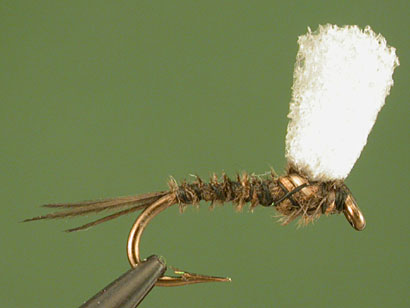
Photo by
Peter Frailey
|
Tying
Sequence:
Hook:
Standard wet fly hook #14 to #18
Thread: 6/0 or 8/0 nylon (black)
Body and Tail: 3 strands of dark turkey
tail fibers
Rib: Tying thread wrapped and counter
wrapped
Head/Wing Case: Small piece of closed
cell foam (white or gray)
Background:
This pattern
was designed to behave like the chironomid as it
goes from the pupal stage to the emergent state.
With careful observation of the natural you can actually see
the gray wing pop up through the water’s surface
and begin to unfurl. The bugs are very vulnerable
at this particular time and the trout will take
them in a very deliberate manner.
If properly
tied, the fly will hang vertically in the water
column and look very much like the natural
insect. |
|
|
Chironomid #2: The Loop Wing
Adult |
|
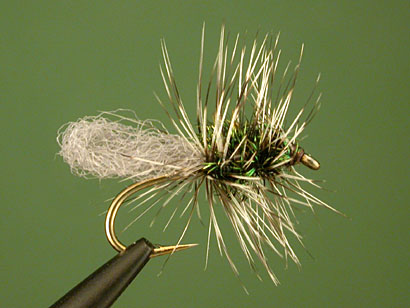
Photo by
Peter Frailey
|
Photo by
Peter Frailey
Tying
Sequence:
Hook:
Standard dry fly hook #14 to #18
Thread: 6/0 to 8/0 nylon (black)
Thorax: Peacock herl
Wing: Floating yarn tied in a loop
(medium blue dun)
Hackle: Dry fly quality grizzly tied
through thorax
Background:
This fly was
designed to simplify the representation of the
newly hatched adult chironomid. My original
attempts at imitating the adults resulted in a
“delta-winged” pattern, which was difficult to
tie, and did not have behavior characteristics
that matched the natural's “skittering”
pre-flight motion.
The “Loop Wing Adult”
incorporates ease of construction with accurate
surface behavior and durability. I now use it
exclusively when the trout are taking the
freshly hatched adults just before they become
airborne. |
|
|
Chironomid #3: The Extended Body “Wiggle” Pupa |
|
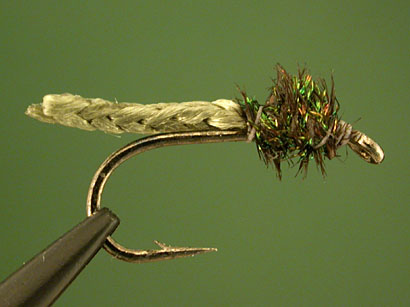
photo by Peter Frailey
|
Tying
Sequence:
Hook:
Standard wet fly hook #14 to #18
Thread: 6/0 to 8/0 nylon (black)
Thorax: Peacock herl
Body: woven nylon “tassel” material
(olive or gray) with the tip glued
Background:
Most
department stores have a crafts section, and
many of them carry woven tassels in a variety of
colors. When short sections of this material are
attached to the hook and extended to the rear of
the fly, an effective undulating motion is built
into the fly.
This
particular pupa pattern is very easy to tie, and
you can crank out many color and size variations
in very short order. Just be sure to fuse the
tip of the extended body with a good waterproof
adhesive so that the tassel material won’t
unravel when you cast the fly. This fly is best
fished with a short deliberate stripping motion,
which allows the body extension to wiggle
seductively. |
|
|
Chironomid #4: The Woody |
|
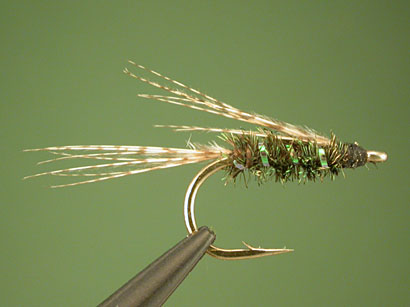
Photo by
Peter Frailey
|
Tying
Sequence:
Hook:
Ring eye hook (either wet fly or dry fly) #14 to
#18
Thread: 6/0 or 8/0 nylon (black)
Tail: Wood duck flank fibers
Body: Peacock herl
Rib: Krystal Flash (pearlescent)
Wing: Wood duck fibers
Background:
It is my
understanding that this is a venerable old
pattern, which has enjoyed a fair amount of
success on the trout ponds of southeastern
Massachusetts. It was shown to me many years
ago, and I remember that it caught some fish
when nothing else seemed to be working.
Looking at
the pattern now in the light of my research on
chironomids, I can find very little about it to
indicate that it tries to imitate any type of
midge. Still, it does incorporate peacock herl,
a proven trout-catching ingredient, and I’ve
never been one to argue with success, so I still
use it. I have added one minor material update
by using Krystal Flash in place of the more
traditional tinsel or wire ribbing. The Woody is
best fished just beneath the surface with a
steady retrieve. You should try to make your
casts to areas where the trout have been rising. |
|
|
Chironomid #5: Midge Pupa |
|
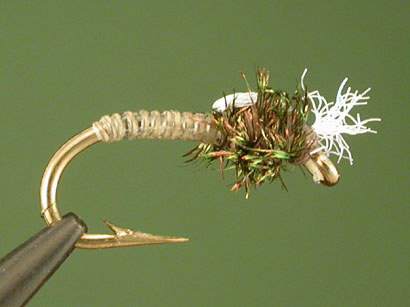
Photo by
Peter Frailey
|
Tying
Sequence:
Hook:
Standard wet fly hook #14 to #18
Thread: 6/0 to 8/0 nylon (white)
Body: Floss, dubbed fur, stripped peacock
herl, or stripped hackle stem. To add
flash, try a single strand of pearlescent
Krystal Flash
Thorax: Peacock herl
Wing Case / Gills: Clear antron fibers
(pulled forward)
Background:
I have used a variety of body materials
in this pupa recipe: floss, dubbed fur, stripped peacock herl
and stripped hackle stems. . All of these have
worked well for me, depending on the situation.
But there are instances when the trout seem to
want a pupa whose body displays
just a bit more flash. So, more recently I have
experimented with single strands of Krystal
Flash. Pearlescent is effective, but try
other colors, too
All my pupal
imitations work best when fished on a long fine
leader with little or no imparted action. If you
keep a fairly tight line, the natural motion of
the wind acting on the surface of the water will
provide just enough movement to draw strikes. As
usual, the best results come from casting to
areas where fish are actively feeding. |
|
|
Chironomid # 6: Dark Dun Emerger |
|
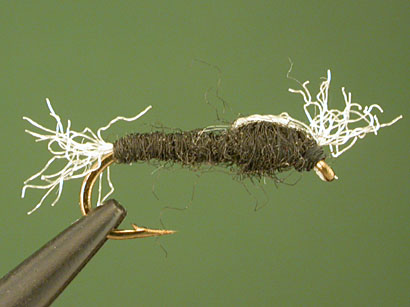
Photo by
Peter Frailey
|
Tying
Sequence:
Hook:
2-X long nymph hook #14 to #18
Thread: 6/0 or 8/0 nylon (black)
Gills (anal): clear antron fibers
Body: fur dubbing (dark dun)
Wing Case/Gills: (cephalic) clear antron
fibers (pulled forward)
Background:
This pattern
is a favorite of my good friend and constant
fishing companion Dennis Fitzgerald. We have
been using it for many years and find it
especially effective on dark days when the trout
want a pattern that is a bit more subdued in
tone. Fish this like any other emerger or pupa. |
|
|
Chironomid #7: The Plastic Pupa |
|
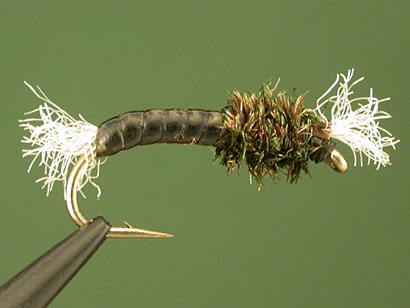
Photo by
Peter Frailey
|
Tying
Sequence:
Hook:
standard wet fly hook #14 to # 18
Thread: 6/0 or 8/0 nylon (black)
Gills: (anal and cephalic) clear antron
fibers
Body: any plastic material like Larva-Lace
or V-Rib (choice of colors)
Thorax: peacock herl
Background:
This is yet
another variation on the same pupa theme.
Its main advantages are increased durability and
a slightly better sink rate. This is fished just
like all the other pupa patterns. Since they are
not difficult to produce, it is easy enough to
carry a good supply of each pattern so you can
go to some alternatives when the action is slow.
Or, if the fishing is very good, I will
sometimes keep switching flies to see if there
is any pattern that isn’t working (this doesn’t
happen nearly often enough).
Some Final Comments:
These seven patterns represent
only the
current stage of development of my midge fly
evolution. They are by no means an end point. I
look forward to each spring so that I can
continue to tinker with these fly designs.
By the way,
if you wanted to simplify the whole fly
selection process for this type of fishing, you
could do no better than to choose the Griffith’s
Gnat. There is no doubt in my mind that
it has been the single most effective chironomid
imitator that I have ever used, and I am never
without it when I’m fishing. Still, I do enjoy
the sense of accomplishment when I tie a new fly
that shows some promise, and I hope I always
will. |
|
|